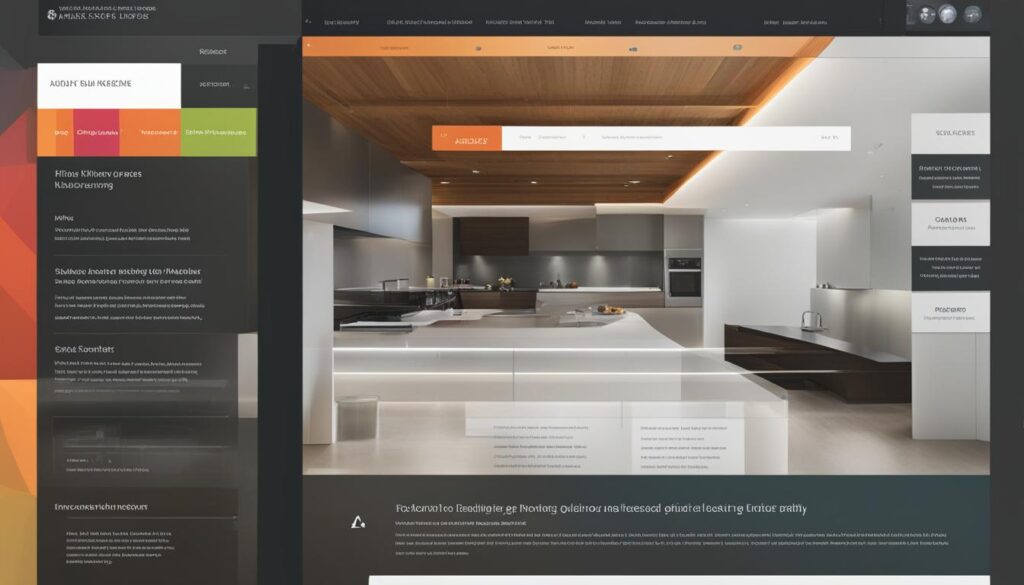Welcome to our article on optimized web design for ADHD business owners. As experts in creating accessible and user-friendly websites, we understand the importance of catering to the unique needs of individuals with ADHD. By implementing ADHD-friendly web design, we can help ADHD professionals thrive in the digital world.
ADHD-aware websites are designed with the principles of web accessibility in mind, ensuring that individuals with disabilities, including ADHD, can engage effectively with online platforms. By adhering to web accessibility guidelines, such as the Web Content Accessibility Guidelines (WCAG) set by the World Wide Web Consortium (W3C), businesses can create inclusive websites that provide a positive user experience for all visitors.
Designing websites specifically for ADHD business owners offers numerous benefits. Not only does it improve user experience and comply with legal requirements, but it also enhances search engine optimization (SEO) and enhances a brand’s image as an inclusive and accessible organization.
Key Takeaways:
- Optimized web design is essential for ADHD business owners to ensure an inclusive and user-friendly online presence.
- Adhering to web accessibility guidelines, such as WCAG, helps create accessible websites for individuals with ADHD.
- Accessible websites improve user experience, compliance with legal requirements, SEO, and brand image.
- Key features of an accessible website include text alternatives, adaptable content, keyboard accessibility, and compatibility with assistive technologies.
- Examples of accessible websites provide actionable insights and inspiration for designing your own inclusive website.
Understanding Web Accessibility
Web accessibility is vital for creating inclusive and accessible websites that cater to individuals with disabilities. At least 15% of the global population experiences some form of disability that can hinder their interaction with standard websites. To address this, organizations should implement web accessibility best practices, as outlined by the World Wide Web Consortium (W3C) and their Web Content Accessibility Guidelines (WCAG).
The WCAG guidelines focus on four key principles: perceivability, operability, understandability, and robustness. By adhering to these principles, businesses can ensure that their website content is presented in multiple formats and that navigation is intuitive for all users.
Creating accessible websites not only demonstrates an organization’s commitment to inclusivity but also expands their reach to a broader audience. By providing equal access to information and services, businesses can foster an inclusive environment for all users.
In the next section, we will delve into the benefits of designing an accessible website and how it can enhance the user experience, comply with legal requirements, boost SEO, and improve a brand’s image.
Benefits of an Accessible Website

Designing an accessible website provides numerous benefits. Firstly, it improves the overall user experience for all visitors, including those with visual impairments, by ensuring high readability and intuitive navigation. A user-friendly website leads to increased engagement and potentially higher conversion rates.
“Having an accessible website not only makes it easier for users to navigate, but it also enhances their satisfaction and increases the chances of them taking desired actions,” says Sarah Thompson, a web accessibility expert.
Secondly, accessibility compliance is a legal requirement that businesses need to meet to provide equal access to information and avoid potential lawsuits. It is not only the right thing to do but also essential for fulfilling legal obligations.
“Ensuring your website is accessible means you are providing everyone, regardless of their abilities, with equal access to your content,” emphasizes legal consultant James Davis.
Furthermore, having an accessible website can positively impact SEO rankings. Search engines favor websites with well-structured layouts, logical hierarchies, and high user satisfaction.
“By optimizing your website for accessibility, you not only improve the experience for users with disabilities but also enhance the overall SEO performance,” states David Johnson, an SEO specialist.
Lastly, an accessible website enhances a brand’s image by showcasing its commitment to inclusivity. It demonstrates that the business values diversity and accessibility, attracting a broader audience and potentially increasing sales.
“Creating an inclusive website not only fosters positive brand perception but also provides a competitive advantage in today’s digitally interconnected world,” states marketing strategist Emily Wilson.
| Benefits of an Accessible Website |
|---|
| Improved user experience for all visitors |
| Compliance with legal requirements |
| Enhanced SEO rankings |
| Positive brand image |
| Broader audience reach |
Key Features of an Accessible Website
Creating an accessible website requires incorporating key features that cater to the needs of individuals with disabilities. By ensuring these features, businesses can provide an inclusive user experience and enhance their reach to a broader audience.
Text Alternatives: Including text alternatives, such as alt text for images, enables screen readers to describe visual content to visually impaired users, ensuring they can access and understand the information presented.
Adaptable Content: Adaptable content allows users to access information in different formats, accommodating diverse access needs. It ensures that individuals with disabilities can consume the content in a way that suits them best.
Distinguishable Content: Making content distinguishable through appropriate color contrast and adjustable text size improves readability for users with visual impairments, enabling them to easily perceive and comprehend the information.
Keyboard Accessibility: Keyboard accessibility is essential for individuals who rely solely on keyboards to navigate a website. It allows them to move through the website’s interactive elements and content without using a mouse or other pointing device.
Navigation Aids: Incorporating navigation aids, such as “Skip to Content” links and breadcrumbs, helps users quickly find the information they need, enhancing usability and facilitating efficient navigation.
Consistent Layout: Maintaining a consistent layout and predictable navigation throughout the website enhances usability for all users, including those with cognitive impairments. It provides a familiar and intuitive experience, reducing cognitive load.
Input Assistance: Providing input assistance, such as clear error messages and labeled form fields, supports users in accurately filling out forms and reduces frustration. It ensures a smooth and efficient form-filling process.
Compatibility with Assistive Technologies: Ensuring compatibility with assistive technologies, such as screen readers and speech recognition software, enables individuals with disabilities to effectively interact with the website. It allows them to access content and navigate the site using the tools that best suit their needs.
An accessible website should incorporate key features to cater to the needs of individuals with disabilities.
Examples of Accessible Websites

Learning from accessible website examples can provide actionable insights for creating your own accessible website. Here are some notable examples:
1. 1% For The Planet
“We use high-contrast colors and keyboard-friendly navigation to ensure a seamless browsing experience for all users.”
2. Apple Accessibility
“Our website hosts a suite of accessibility features such as adjustable display settings and VoiceOver functionality.”
3. Partake Foods
“We incorporate descriptive labels for form elements and offer a range of accessibility alternatives to meet the diverse needs of our users.”
Examining these examples from various industries can inspire and inform the design and development of an accessible website.
| Website | Features |
|---|---|
| 1% For The Planet | High-contrast colors, keyboard-friendly navigation |
| Apple Accessibility | Adjustable display settings, VoiceOver functionality |
| Partake Foods | Descriptive labels for form elements, range of accessibility alternatives |
ADHD-Friendly Digital Content

Making digital content more ADHD-friendly can greatly enhance its effectiveness for individuals with ADHD. To achieve this, there are several key factors to consider:
- Short and Concise Text: Keeping text brief and to the point improves readability and skimmability. Avoid long-winded explanations and instead focus on delivering information in a clear and concise manner.
- Logical Order: Organize content in a logical and sequential order. This helps individuals with ADHD follow the flow of information and easily understand the intended message.
- Clear Call to Action: Including a prominent call to action helps individuals with ADHD stay focused and engaged. Use actionable language and make the desired action easily accessible.
- Dark Mode Compatibility: Dark mode compatibility reduces visual strain and enhances readability, providing a more comfortable viewing experience for users who prefer dark backgrounds.
Visual breaks also play a crucial role in creating ADHD-friendly content. Breaking up text with relevant graphics, such as diagrams, illustrations, or charts, helps alleviate the “wall of text” effect and makes the content easier to navigate and comprehend.
Using visual elements such as bold or italicized text, headings, and colored backgrounds can further enhance the readability and clarity of the content. These visual cues provide visual breaks and highlight essential information, making it easier for individuals with ADHD to process and retain information.
A balanced use of visuals is important to ensure they enhance the content without becoming overwhelming or distracting. The goal is to provide a visually engaging experience that complements the text and helps individuals with ADHD focus on the essential information.
By implementing these strategies and creating ADHD-friendly digital content, businesses can ensure their messages are effectively communicated and resonate with their target audience.
Managing ADHD as a Business Owner
As business owners with ADHD, we face unique challenges that can impact our productivity. However, by implementing effective strategies, we can overcome these challenges and maximize our success.
Prioritization
One key strategy is prioritization. By determining the most important tasks and focusing on them first, we can ensure that we make progress on crucial business activities. This helps us stay on track and meet deadlines effectively.
Task Pivoting
There may be times when our ADHD brain struggles to focus on a specific task. In these situations, task pivoting can be helpful. Task pivoting involves switching to a different task that can be accomplished at the moment, allowing us to maintain productivity even when focus is a challenge.
Changing Environment
Creating an environment that supports our focus is essential. Experiment with different settings to determine where you feel most focused and productive. Some individuals with ADHD find certain locations or setups to be more conducive to concentration.
Structure and Routine
Establishing structure and routine in our daily lives can provide a framework for managing tasks and staying organized. Creating to-do lists, using digital calendars, and setting specific work hours can help us maintain a sense of order and prioritize our activities effectively.
Limiting Distractions
ADHD individuals are easily distracted, so it’s crucial to limit distractions for optimal focus. Putting our phones on do not disturb mode, reducing visual and auditory stimuli, and creating a dedicated workspace can help create an environment that promotes better focus and productivity.
By implementing these strategies, we can manage our ADHD effectively and become successful business owners. It’s important to remember that there is no one-size-fits-all approach, so it may take some trial and error to find what works best for us. With persistence and dedication, we can conquer the challenges of ADHD and thrive in our entrepreneurial journey.
Embracing ADHD as a Superpower

ADHD can be seen as a superpower when we learn to harness its strengths. Many entrepreneurs with ADHD have leveraged their focus and hyperfixation abilities to excel in tasks they are passionate about. The key is to create a customized work environment that caters to our individual needs and allows us to thrive.
By finding the perfect setting or implementing specific routines, we can enhance our productivity and maximize our potential. Embracing the uniqueness of ADHD and recognizing it as a valuable asset empowers us to tap into our strengths and achieve success in our business endeavors.
Harnessing ADHD Strengths
Individuals with ADHD often possess exceptional skills that can be leveraged for professional success. Some of these strengths include:
- Hyperfocus: The ability to intensely concentrate on tasks of interest for extended periods.
- Creativity: A unique perspective and ability to think outside the box.
- Energetic: A high level of energy and enthusiasm, which can drive productivity.
- Intuition: A heightened ability to make quick, instinctual decisions.
By identifying and capitalizing on these strengths, we can unleash our full potential and make a significant impact in our business ventures.
Customized Work Environment
To harness ADHD strengths effectively, it’s important to create a work environment tailored to our individual needs. This can include:
- Optimal Setting: Finding a workspace that minimizes distractions and promotes focus. This might involve choosing a quiet location or using noise-cancelling headphones.
- Routines and Rituals: Implementing daily routines and rituals that help organize tasks and maintain structure.
- Task Management Tools: Utilizing digital tools and strategies to break down tasks and stay organized.
By customizing our work environment, we can create the ideal conditions for productivity and success.
“By embracing our unique traits and creating a supportive work environment, we can unlock our potential and accomplish great things.”
Embracing Uniqueness
ADHD is not a limitation; it is a unique quality that sets us apart. Embracing our ADHD and recognizing it as a valuable asset allows us to approach challenges with fresh perspectives and innovative ideas. By embracing our uniqueness, we can confidently pursue our passions and achieve extraordinary success.
Conclusion
At WebDesigner.Business, we understand the importance of optimized web design and ADHD-friendly content for business owners. By incorporating accessibility features into website design and creating content that caters to individuals with ADHD, we can enhance user experience, broaden your reach, and maximize productivity.
Designing inclusive websites that adhere to web accessibility guidelines ensures equal access to information and services for all users. By implementing ADHD-friendly content, we make digital content more engaging and easier to consume, catering specifically to the unique needs of individuals with ADHD.
Managing ADHD as a business owner can be challenging, but with effective strategies in place, you can overcome obstacles and maximize productivity. By understanding the challenges and leveraging the strengths of ADHD, you can create a customized work environment and prioritize tasks effectively.
Are you ready to optimize your web design, create ADHD-friendly content, and streamline your online success? Visit our website to learn more about our tailored web design services designed specifically for ADHD business owners.
FAQ
What is web accessibility?
Web accessibility refers to the design and development of websites that can be accessed and used by individuals with disabilities. It ensures that people with various disabilities, including ADHD, can navigate, perceive, and interact with online content effectively.
Why is web accessibility important for ADHD business owners?
Web accessibility is crucial for ADHD business owners as it allows them to create user-friendly online platforms that cater to the needs of individuals with ADHD. By implementing accessibility features, websites can be designed in a way that minimizes distractions, enhances readability, and improves overall user experience.
What are the benefits of having an accessible website?
An accessible website provides numerous benefits, including improved user experience for all visitors, compliance with legal requirements, enhanced SEO rankings, and a positive brand image that showcases inclusivity and accessibility.
What are some key features of an accessible website?
Key features of an accessible website include text alternatives for images, adaptable content, distinguishable content through color contrast, keyboard accessibility, navigation aids like “Skip to Content” links, consistent layout, predictable navigation, input assistance with clear error messages, and compatibility with assistive technologies.
Can you provide examples of accessible websites?
Sure! Some notable examples include 1% For The Planet, Apple Accessibility, and Partake Foods. These websites showcase various accessibility features and provide inspiration for designing inclusive websites.
How can digital content be made more ADHD-friendly?
Digital content can be made more ADHD-friendly by keeping text short and concise, using bullet points, organizing content logically, including clear and easily accessible calls to action, offering dark mode compatibility, using relevant graphics to break up text, and finding a balanced approach to the use of visuals.
What are some strategies for managing ADHD as a business owner?
Strategies for managing ADHD as a business owner include prioritization, task pivoting, changing the environment to improve concentration, establishing structure and routine, and limiting distractions such as keeping phones on do not disturb mode.
How can ADHD be embraced as a superpower?
ADHD can be embraced as a superpower by creating a customized work environment, leveraging focus and hyperfixation abilities, and recognizing ADHD as a valuable asset that brings unique strengths to business endeavors.
How can web design be optimized for ADHD business owners?
Web design can be optimized for ADHD business owners by incorporating accessibility features, creating ADHD-friendly digital content, and ensuring inclusivity in website design. These measures can enhance user experience, broaden reach, and maximize productivity.

Leave a Reply